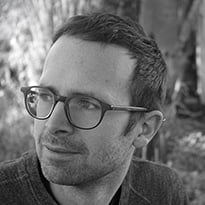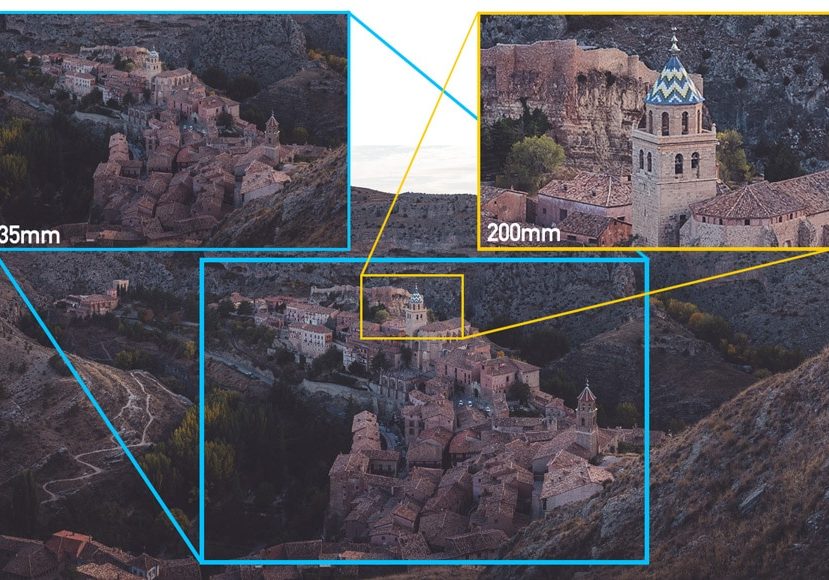
What is Focal Length in Photography? Understanding Lenses
Learn how the focal length of your lens affects every image you take, how to choose the right focal length, and why it's such an important topic in photography.
Learn | Photography Guides | By Andy Day
Why is focal length important in photography? Do you really need to understand it to take good photos?
Understanding focal length and how it affects your angle of view is crucial for every photographer.
It will help you when you’re out taking photographs, but also give you knowledge that’s important when choosing a camera and lens, and an understanding of how the two work together to determine how much of the scene in front of you can be captured.
So let’s dive into everything you need to know about focal lengths.
Table of Contents
What is Focal Length?
Focal length is the system used in photography to describe how wide or tight a lens is. Listed as a number and measured in millimetres — e.g., 35mm, 85mm — it tells you how much of a scene a lens can capture, and how big subjects will appear.
The number gives an indication of the angle of view that a lens can see.
The lower the focal length number, the wider the angle. The higher the number, the narrower the angle (and the more “zoomed-in” the result).
Prime lenses have a fixed focal length and are described by one number — e.g, 50mm. The angle of view cannot be changed.
Zoom or telephoto lenses allow you to change the focal length and the lens is described by two numbers — the minimum and maximum focal lengths. For example, a typical zoom lens might have a focal length of 18-55mm, or 24-70mm.
Focal length comes from the distance between a specific part of a lens (the “optical centre”) and the image sensor (or film plane) where the image is recorded.
The wider the angle of view that a lens offers, the smaller this distance, and the lower the number.
What is the Angle of View?
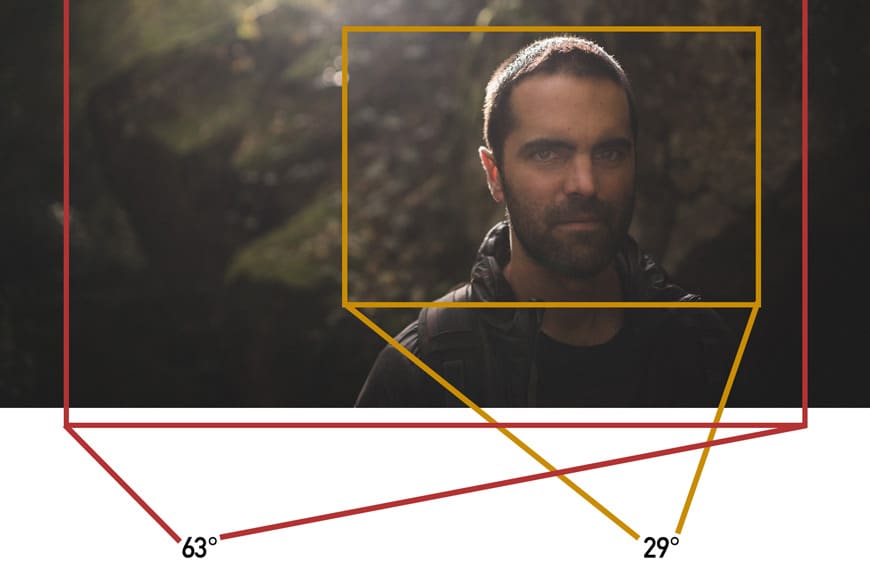
Angle of view describes how wide or narrow a lens is. When looking at a scene, a wider angle of view will capture a greater area while a narrower angle of view will capture a smaller area.
If you imagine your arms as capturing the scene in front of you, holding them straight out on each side would give a 180° angle of view. Holding your arms out with your hands, say, one inch apart, your angle of view might be just 1°.
A 35mm lens might give an angle of view of 63°, an 85mm lens might give you 29°, and a 200mm lens just 12°.
You will also encounter the term “field of view” and for most camera manufacturers, angle of view and field of view are the same thing.
However, some technically-minded photographers will argue is that field of view is slightly different from the angle of view as it is also determined by the size of the sensor inside your camera.
As will be explained below, a 24mm lens might have a 59° field of view when used on a full-frame camera, but a 94° field of view when used on an APS-C camera.
You can learn more about the pros and cons of full-frame and crop sensor cameras here and also discover what is field of view in cameras.
How does the Focal Length affect the image?
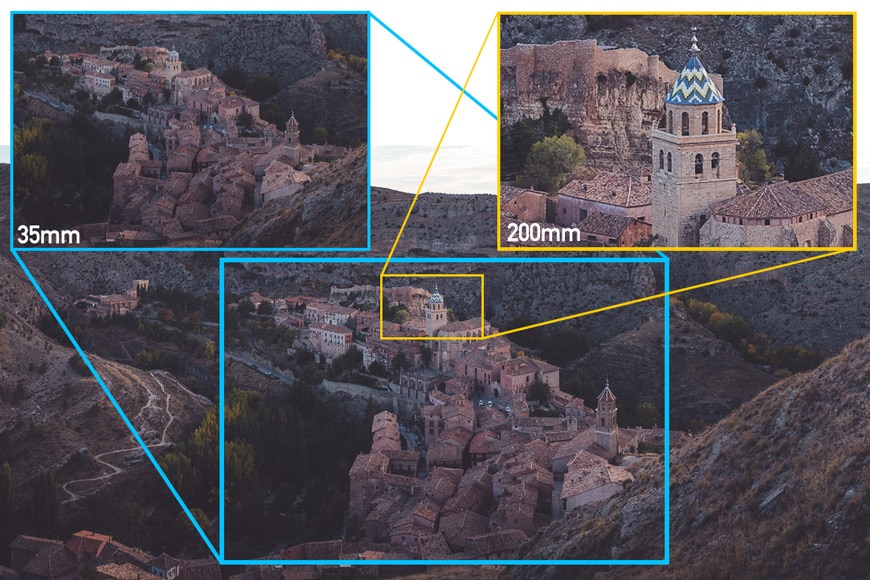
Focal length determines how much of a scene you will be able to capture, but also how big your subjects will appear.
A wide-angle lens will let you capture more of the scene in front of you but subjects will appear smaller compared to using a lens with a longer focal length.
In addition, a longer lens — i.e., a lens with a longer focal length — will compress the scene. This means that the subject and the background will appear to be closer together.
In the below example, one photograph was taken at a focal length of 24mm and the other at a focal length of 70mm.
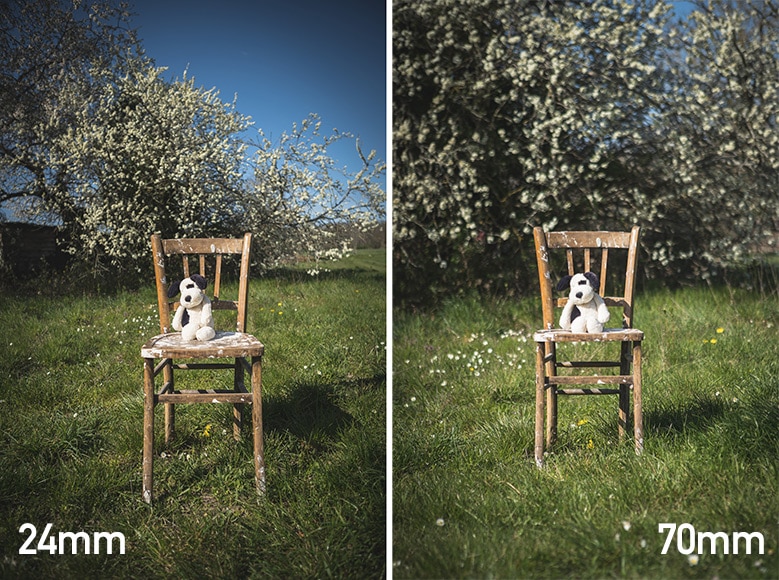
I took the 24mm photograph first. To keep the teddy bear the same size in relation to the frame, I stepped further away from the chair and took a photograph at 70mm.
Note that the tree in the background looks further away on the left and closer on the right.
You might notice other differences. For example, the chair appears to be wider in the 24mm photo and narrower in the 70mm photo.
This is because the lens focal length changes the geometry of a scene.
Taking portraits with a wide-angle camera lens can make a subject’s face look distorted, stretching out their nose and making their face look very narrow. This is because the wide-angle lens requires you to be much closer to your subject.
Wide-angle lenses introduce distortion, seeming to stretch parts of the scene, particularly towards the edges of the frame.
(See also: What Is the Best Focal Length for Portraits?)
Consider the chair in the photos below:
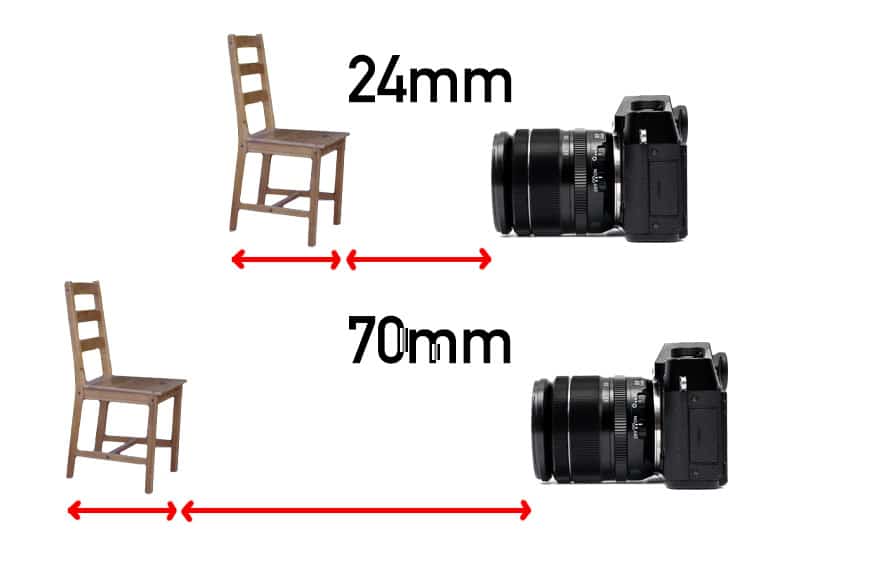
Then consider the distance between the legs in relation to the distance between the camera and the chair.
The different ratios are responsible for the difference in how the camera perceives each chair geometrically when shooting at different focal lengths.
This difference in ratios also explains why the tree looks further away when shot at 24mm and closer when shot at 70mm.
Another effect is that the background is more blurry at the 70mm focal length compared to the 24mm focal length:
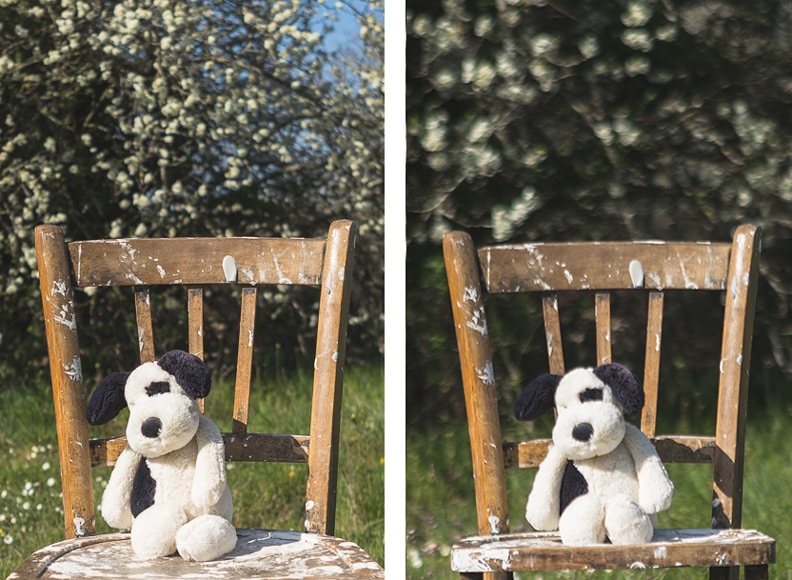
This is because lenses with a longer focal length create images that have a shallower depth of field. A shallow depth of field means that less of the scene will be in focus.
There are other factors that affect the depth of field: how close the in-focus subject is to the lens and the size of the aperture.
You can read more about the effect of a shallow depth of field here and how to get infinite depth of field here.
How Do You Choose Focal Length?
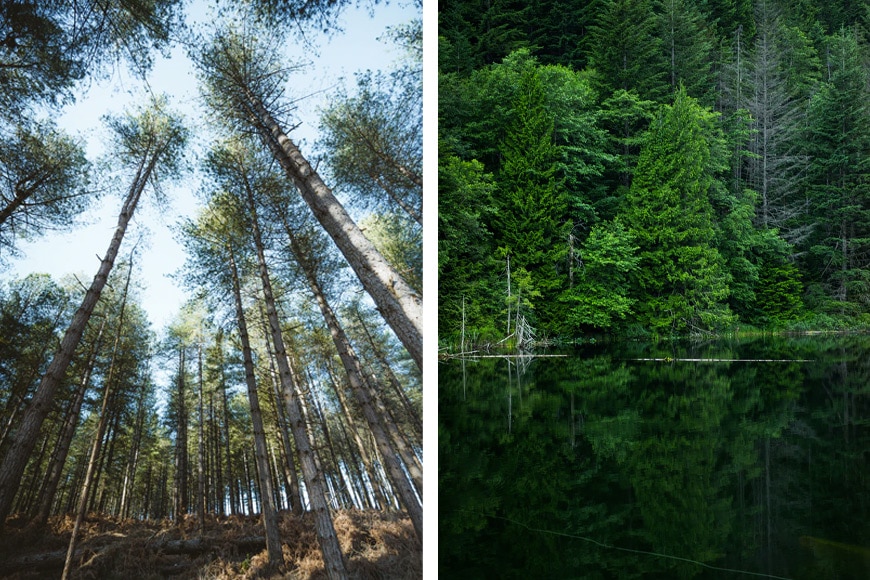
© Annie Sprat (left) and © Bryce Evans
Trying to decide which focal length is best all comes down to personal preference and what it is that you are photographing.
For example, some landscape photographers prefer to work with ultra-wide-angle lenses such as 14mm. Other photographers prefer much longer focal lengths for capturing the same scene.
Choosing which focal length to use will usually be determined by how big you want your subject to be within your photograph and how close you can position yourself.
If you’re photographing an interior, you might be better off with 20mm or even wider focal lengths as you won’t have much space in which to work.
As seen above, distortion is also a factor. Longer focal lengths of 50mm and above tend to be better for portraits as they are more flattering to facial features.
Longer lenses such as 105mm or 200mm are good for sports where the action is happening quite far away from you.
What is an Equivalent Focal Length? (aka Field of View)
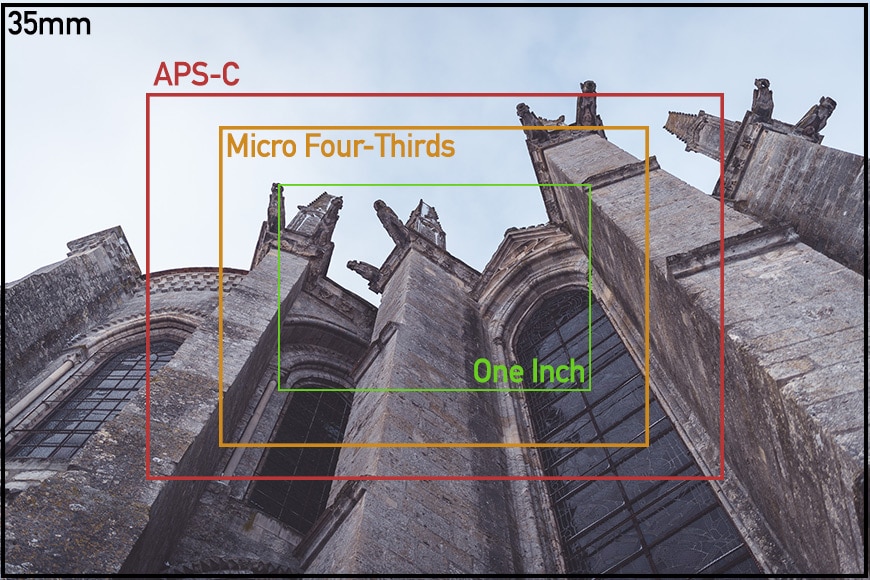
For most of photography’s history, photographs were taken on film, recording images that measured 36mm tall and 24mm wide.
With the sprocket holes, the physical film was 35mm in height, giving the film the name “35mm.” (Confusingly, 35mm film is sometimes referred to as “135 format.”)
When digital sensors were invented, this 36 x 24mm image was used as the standard and is now called “full frame.”
Other camera sensor sizes exist — most of which are smaller than full-frame — such as APS-C, Micro Four Thirds, One Inch, and many others. (There are larger sensors, too.)
When light passes through a lens, the scene being captured is projected by the lens as a circular image which is directed onto the camera sensor. If a sensor is smaller, less of that image circle falls onto the sensor:
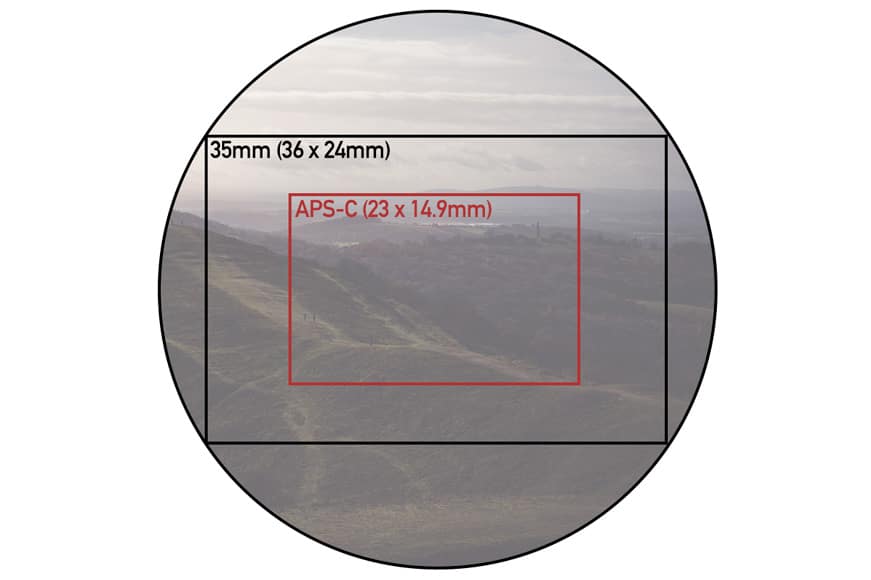
As you can see, less of the scene is captured. For this reason, an APS-C sensor is often called a “crop sensor” as it doesn’t capture as much of the image when compared to full-frame.
The image shown above was taken on a full-frame camera using a 50mm lens. If the camera were to be swapped out for an APS-C camera, the resulting image would be narrower because the smaller sensor captures a smaller field of view.
In fact, it would be like using a lens with a focal length of 80mm on a full-frame camera.
For this reason, when photographers discuss lenses for APS-C and Micro Four Thirds cameras, you will hear them talk about the equivalent focal length.
Equivalent focal length refers to the focal length of a lens that would give the same field of view on a full frame camera.
(This can be confusing because full frame cameras are frequently called 35mm cameras! You might hear photographers say that a 20mm lens is the 35mm equivalent of 32mm — as if this wasn’t complicated enough!)
For example, a full-frame sensor is 1.6 times bigger than an APS-C sensor. A 50mm lens used on an APS-C camera would be like looking through an 80mm lens on a full-frame camera.
(Note: Canon and Sony APS-C sensors have a “crop factor” of 1.6x. Sony APS-C sensors are a slightly different size and have a crop factor of 1.5x. Micro Four Thirds sensors have a crop factor of 2x.)
Here’s a guide to lenses for Sony APS-C sensor cameras.
What are the Most Common Focal Lengths?
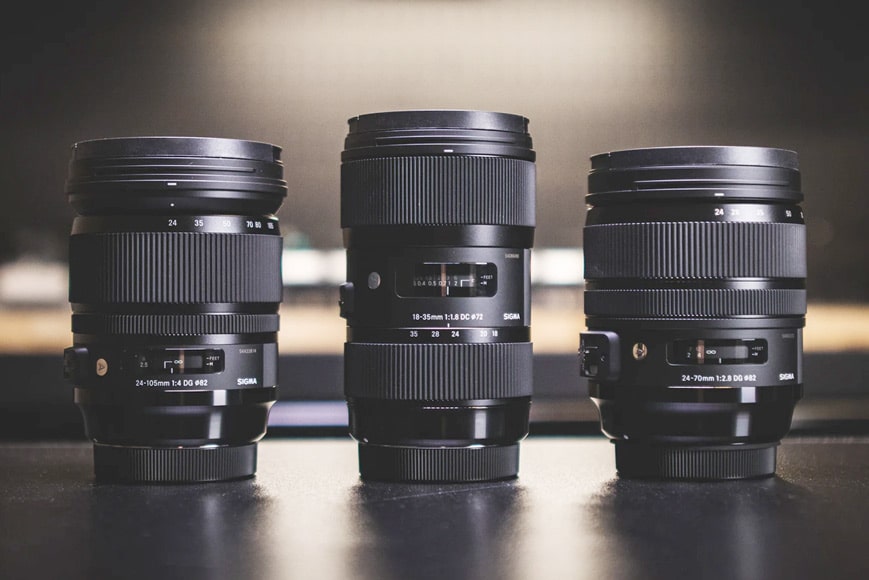
© Voice + Video
Different focal lengths tend to get used for certain types of shooting.
Here are the different types of lens (though some photographers would place these boundaries differently!) and some broad generalisations about how they are used:
- Fisheye: Lenses with focal lengths around 8-12mm produce a very distorted, circular image. Such lenses were popular with skateboarders during the 1990s.
- Ultra-wide: Anything up to 24mm. Often used for dramatic landscapes, extreme sports, and real estate photography. They give a huge amount of depth of field.
- Wide: 24mm to 35mm. General use, street photography, full-length portraits, landscapes, architecture. They give lots of depth of field.
- Standard: 40mm to 75mm. General use, group portraits, street photography, architecture, mid-length portraits. It’s easier to separate your subject using the shallow depth of field.
- Telephoto: 85mm to 300mm. Portraits, headshots, wildlife, photographing sports from the sidelines. The depth of field is very shallow.
- Super telephoto: 300mm and longer. Distant subjects, particularly animals and birds. The depth of field is razor-thin. These lenses can be incredibly expensive.
For more information on different focal length lenses, check out this useful article.
Is a Prime Lens Better Than a Zoom?
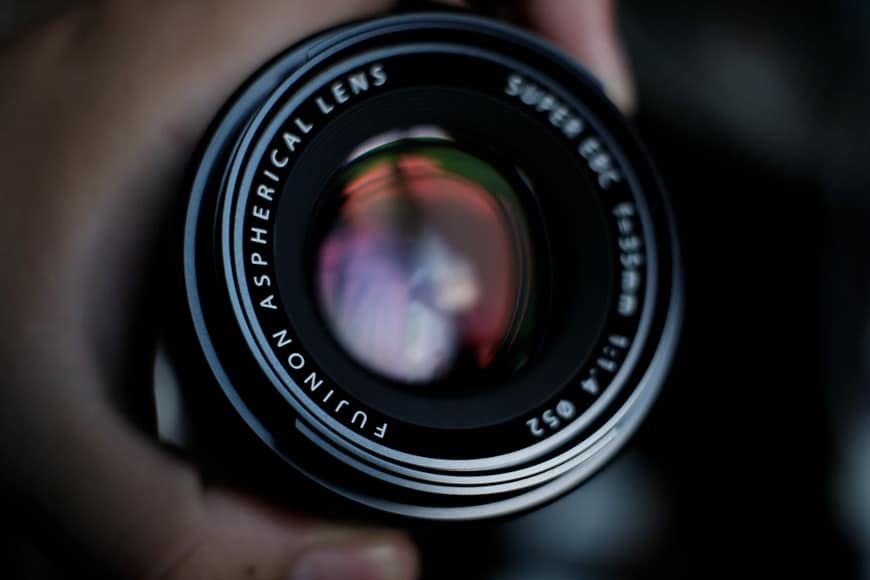
© Ganda Lukman
A prime lens has a fixed focal length and isn’t as versatile as a zoom lens. However, using a prime lens makes you move around which some photographers prefer as it makes them more creative and involved with the scene.
Zoom lenses — particularly the non-professional ones — tend not to be as sharp as prime lenses.
Prime lenses are often cheaper and more compact; they also often have a much larger maximum aperture.
For more information on the differences, check out this article.
Focal Length & Angle of View FAQs
What is 50mm focal length good for?
50mm is probably the most versatile focal length for a prime lens. It’s great for portraits, landscapes, and street photography, and if it has a maximum aperture of f/1.8, it will teach you about using a shallow depth of a field.
How far can a 600mm lens see?
A 600mm lens will bring distant objects very close. As a guide, the moon will fill about ¼ of the frame when using a full-frame camera, and when shot from about ten metres, a hummingbird will fill around half.
Why is 35mm the best focal length?
35mm is a very versatile focal length that is great for everyday use. There’s a good depth of field which means that most of your photographs will be sharp, and there’s enough space in the frame that photographing pets and children will not be too challenging if they’re moving quickly!
What is the best focal length for portraits?
Photographers often think that 85mm or longer are the best focal lengths for portraits as 50mm and below can cause facial features to become distorted. However, even 35mm can be great if you want to emphasise your model’s long limbs, or if you want to give your subject some context and shoot an environmental portrait.
How far away can I shoot with a 50mm lens?
As a general rule, with a 50mm focal length, if you can see it, you can photograph it. However, if it’s small to your eye, 50mm will not make it very big in your frame so you might want to get a lot closer.
What is a 12mm lens good for?
A 12mm lens on an APS-C camera gives a field of view of almost 100° which is ultra-wide-angle. This is great for creating dramatic, sweeping landscapes, photographing interiors, or capturing extreme sports close-up.
Should I get a 50mm or 35mm lens?
Both 35mm and 50mm are good focal lengths for photographing the people around you, street photography, and travel. 35mm is better suited to fast-moving subjects and scenarios where it might be trickier to nail focus. 50mm has a tighter field of view and is better for creating cinematic images using a shallow depth of field.
Final Words
Understanding focal length and how the length of a lens will affect your images is a major step in starting out on your photographic journey.
There’s more to it than just how close you can bring a subject, or how wide an angle of a scene you can take in, and knowing how it all relates is critical when deciding which lens focal length to buy.
Hopefully, you found this guide useful. If you have any questions about understanding focal length, don’t hesitate to get in touch in the comments below!











